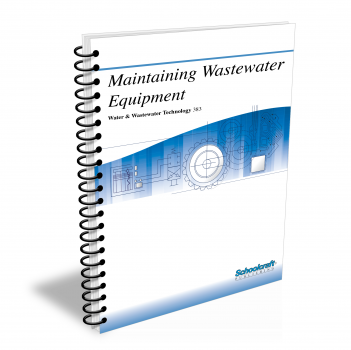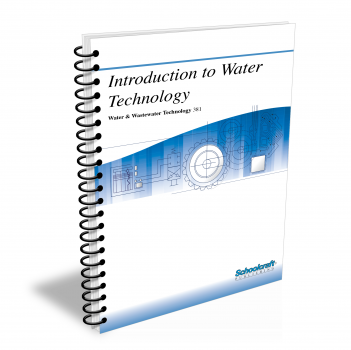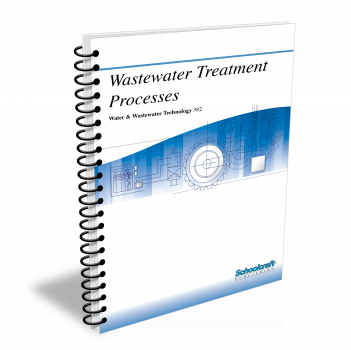Maintaining Wastewater Equipment

Course Number: 383
The Maintaining Wastewater Equipment textbook covers the equipment used in handling and treating wastewater. It outlines correct facility maintenance procedures, including necessary checks and testing of solids handling equipment. Also included is the maintenance of flow measurement devices and the safety precautions of workers in the treatment plant environments.
Does your curriculum require additional topics not included in this textbook? Build a customized version of the Maintaining Wastewater Equipment textbook below.
Recommended Contact Hours – 10
Preview a Chapter
Available Supporting Material
- Table of Contents
- Exam Copies
- Suggested Titles
Table of Contents
Chapter 1: Pumping Stations
Topics: Pump stations; Pump types, operation, and maintenance; Drive units; Piping; Controls; Level detection; Safety
Learning Objectives:
- Describe a typical collection system layout.
- Name the three types of pumping stations currently in use and explain how they differ.
- List seven basic components of wet-well and dry-well stations.
- Use the following terms in an explanation of pump operation: impeller, shroud, volute case, stuffing box, shaft sleeve, wearing ring.
- Name the important elements of a good preventive maintenance program for pumps.
- Explain the importance of a pump station ventilation system.
- Demonstrate the necessary procedures to follow before pump start-up.
Chapter 2: Screening and Grinding Equipment
Topics: Bar screens; Grinders; Rotating drum comminutors; Stationary screen comminutors with oscillating cutters; Barminutors
Learning Objectives:
- Name the two basic parts of a hand-cleaned bar screen and explain their functions.
- Describe the operation of a mechanically cleaned bar screen.
- Explain why grinders are used and how they are maintained.
- Compare and contrast a rotating drum comminutor and a stationary screen comminutor with an oscillating cutter.
- Explain how a Barminutor combines the functions of a bar screen and a comminutor.
- Give examples of important safety rules to follow when working with screening and grinding equipment.
Chapter 3: Grit Removal Systems
Topics: Grit chambers; Detritus tanks; Chain and flight grit collectors; Aerated grit chambers; Cyclone separators
Learning Objectives:
- Tell why grit removal is important.
- Name the three phases of the grit removal process.
- Explain the functions of slide gates and dewatering drains in handcleaned grit chambers.
- Describe the action of a reciprocating rake and explain its purpose.
- List several maintenance checks to make on chain and flight grit collectors.
- Explain how an aerated grit chamber works and how to tell if it is not working correctly.
- Describe the operation of a cyclone grit separator.
Chapter 4: Sludge- and Scum-Collection Apparatus
Topics: Sedimentation; Clarifiers; Scum and sludge removal; Lab testing; Maintenance; Troubleshooting; Safety
Learning Objectives:
- Describe the operation of slottedpipe and helical-type skimmers.
- Name the two flow patterns possible in circular clarifiers.
- Discuss the daily maintenance requirements of clarifiers.
- Explain the importance of laboratory testing on the contents of a clarifier.
- Identify possible safety hazards associated with clarifier operation.
Chapter 5: Flow Measurement Devices
Topics: Flow measurement in batch processes, filled pipes, open channels, and freely discharging pipes; Depth and pressure measurement
Learning Objectives:
- Define flow and differentiate between flow rate and total flow.
- List the three basic types of flow systems.
- Distinguish between direct and indirect flow measurements, and between primary and secondary devices.
- Give a brief description of a current meter, a pitot tube, a weir, and a flume, and tell how each functions in open channels.
- Describe several methods of measuring flow from freely discharging pipes.
- Name at least five level detection devices and explain their operation.
- Describe the following flow measurement devices as they are used in completely filled pipes: orifice, venturi, flow nozzle, rotameter, magnetic flowmeter, and ultrasonic flowmeter.
Request Exam Copies
Exam Copies
Ready to see a copy of our textbooks? After selecting which textbooks you’d like to review for your course, you can submit your request by either logging in or creating an account so we know where to ship your exam copies. A representative from Schoolcraft will contact you to confirm and finish processing your request.
Exam copies are always free and yours to keep.
Selected Exam Copies
none selected
* Maximum of five copies can be ordered

